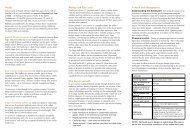Bushland Weeds Manual - Environmental Weeds Action Network
Bushland Weeds Manual - Environmental Weeds Action Network
Bushland Weeds Manual - Environmental Weeds Action Network
Create successful ePaper yourself
Turn your PDF publications into a flip-book with our unique Google optimized e-Paper software.
58<br />
Chapter 5 Broadleaf Herbs, Sedges and Succulents<br />
• Success will often depend on at least one or two<br />
year’s site preparation and seed collection and a<br />
long-term access to resources for follow-up work.<br />
• Results will vary across sites, soils, seasons, plant<br />
communities and species selected.<br />
• Ensure appropriate permits have been acquired<br />
before seed collection is undertaken.<br />
Control methods<br />
There are 60 species of annual weeds listed in the table<br />
at the end of the chapter. Methods of control are often<br />
going to be quite specific for each species.<br />
Nevertheless, some useful generalisations can be made.<br />
Physical control<br />
• Hand-removal is only useful before seed set and all<br />
flowering material should be taken from a site. Left<br />
behind, it may well go on to produce seed.<br />
• Mowing or brushcutting can reduce seed production<br />
and reduce populations if carried out well before<br />
seed set. As slashing is non-specific it is really only<br />
useful in highly degraded sites. Work needs to be<br />
Box 5.3 Managing annual weeds after Arum Lily control – experience from the banks of<br />
Bennett Brook<br />
Trials on different methods to control Arum Lily along Bennett Brook highlight the invasive potential of annual<br />
weeds. The trials were located in a very degraded patch of Flooded Gum (Eucalyptus rudis) – Swamp<br />
Paperbark (Melaleuca rhaphiophylla) woodland. The understorey in most places was a monoculture of Arum<br />
Lily. <strong>Weeds</strong> that moved into areas where Arum Lily had been controlled included 12 species of annual weeds<br />
(nine broadleaf herbs and three species of annual grasses) (Table 1.).<br />
Interestingly, the only natives to move into the site were four species of herbaceous perennials, all of them<br />
fast-growing, easily-propagated, mat-forming plants highly suitable for displacing weeds, particularly those<br />
with an annual life-cycle. Such species are often present in disturbed wetland sites and they provide a great<br />
opportunity to quickly fill gaps, helping prevent further germination of annual weeds.<br />
Slender Knot Weed (Persicaria decipiens).<br />
Water Buttons (Cotula coronopifolia).<br />
Table 1. <strong>Weeds</strong> and natives that colonised the site following<br />
removal of Arum Lily.<br />
WEEDS<br />
Annual Grasses<br />
Annual Rye Grass Lolium sp.<br />
Annual Veldgrass Ehrharta longiflora<br />
Annual Barb Grass<br />
Perennial Grasses<br />
Polypogon monspeliensis<br />
Phalaris<br />
Annual Herbs<br />
Phalaris aquatica<br />
Bushy Starwort (annual or biennial) Symphyotrichum subulatum<br />
Pimpernel Anagallis arvensis<br />
Common Starwort Callitriche stagnalis<br />
Pattersons Curse Echium plantagineum<br />
Lesser Loosestrife Lythrum hyssopifolium<br />
Slender Birds Foot Trefoil Lotus angustissimus<br />
Plantain (or short-lived perennial) Plantago major<br />
Sow Thistle Sonchus oleraceus<br />
Sharp Buttercup<br />
Perennial Herbs<br />
Ranunculus muricatus<br />
Clustered Dock Rumex conglomeratus<br />
Water Cress<br />
NATIVES<br />
Perennial Herbs<br />
Rorippa nasturtium-aquaticum<br />
Juncus microcephalus<br />
Water Buttons Cotula coronopifolia<br />
Centella Centella asiatica<br />
Joy Weed Alternanthera nodiflora<br />
Slender Knot Weed Persicaria decipiens



